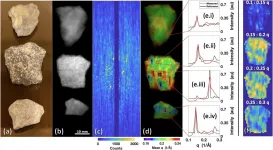Artificial intelligence predicts brain age from EEG signals recorded during sleep studies
Brain age indices have potential value as diagnostic biomarkers and 'vital signs' of brain health
2021-06-09
(Press-News.org) DARIEN, IL - A study shows that a deep neural network model can accurately predict the brain age of healthy patients based on electroencephalogram data recorded during an overnight sleep study, and EEG-predicted brain age indices display unique characteristics within populations with different diseases.
The study found that the model predicted age with a mean absolute error of only 4.6 years. There was a statistically significant relationship between the Absolute Brain Age Index and: epilepsy and seizure disorders, stroke, elevated markers of sleep-disordered breathing (i.e., apnea-hypopnea index and arousal index), and low sleep efficiency. The study also found that patients with diabetes, depression, severe excessive daytime sleepiness, hypertension, and/or memory and concentration problems showed, on average, an elevated Brain Age Index compared with the healthy population sample.
According to the authors, the results demonstrate that these health conditions are associated with deviations of one's predicted age from one's chronological age.
"While clinicians can only grossly estimate or quantify the age of a patient based on their EEG, this study shows an artificial intelligence model can predict a patient's age with high precision," said lead author Yoav Nygate, senior AI engineer at EnsoData. "The model's precision enables shifts in the predicted age from the chronological age to express correlations with major disease families and comorbidities. This presents the potential for identifying novel clinical phenotypes that exist within physiological signals utilizing AI model deviations."
The researchers trained a deep neural network model to predict the age of patients using raw EEG signals recorded during clinical sleep studies performed using overnight polysomnography. The model was trained on 126,241 sleep studies, validated on 6,638 studies, and tested on a holdout set of 1,172 studies. Brain age was assessed by subtracting individuals' chronological age from their EEG-predicted age (i.e., Brain Age Index), and then taking the absolute value of this variable (i.e., Absolute Brain Age Index). Analyses controlled for factors such as sex and body mass index.
"The results in this study provide initial evidence for the potential of utilizing AI to assess the brain age of a patient," said Nygate. "Our hope is that with continued investigation, research, and clinical studies, a brain age index will one day become a diagnostic biomarker of brain health, much like high blood pressure is for risks of stroke and other cardiovascular disorders."
The research abstract was published recently in an online supplement of the journal Sleep and will be presented as a poster beginning June 9 during Virtual SLEEP 2021. SLEEP is the annual meeting of the Associated Professional Sleep Societies, a joint venture of the American Academy of Sleep Medicine and the Sleep Research Society.
INFORMATION:
This study was supported by EnsoData, a healthcare artificial intelligence (AI) company. EnsoData's initial product, EnsoSleep, is an AI scoring and analysis solution that provides automated event detection in sleep studies.
For a copy of the abstract, "EEG-Based Deep Neural Network Model for Brain Age Prediction and Its Association with Patient Health Conditions," or to arrange an interview with the study author or an AASM spokesperson, please contact AASM Communications Coordinator Corinne Lederhouse at 630-737-9700, ext. 9366, or clederhouse@aasm.org.
About the American Academy of Sleep Medicine
Established in 1975, the American Academy of Sleep Medicine (AASM) is advancing sleep care and enhancing sleep health to improve lives. The AASM has a combined membership of 11,000 accredited member sleep centers and individual members, including physicians, scientists and other health care professionals (aasm.org).
About the Sleep Research Society
The Sleep Research Society (SRS) is a professional membership society that advances sleep and circadian science. The SRS provides forums for the exchange of information, establishes and maintains standards of reporting and classifies data in the field of sleep research, and collaborates with other organizations to foster scientific investigation on sleep and its disorders. The SRS also publishes the peer-reviewed, scientific journals Sleep and Sleep Advances (sleepresearchsociety.org).
ELSE PRESS RELEASES FROM THIS DATE:
2021-06-09
The widely studied metallic asteroid known as 16 Psyche was long thought to be the exposed iron core of a small planet that failed to form during the earliest days of the solar system. But new University of Arizona-led research suggests that the asteroid might not be as metallic or dense as once thought, and hints at a much different origin story.
Scientists are interested in 16 Psyche because if its presumed origins are true, it would provide an opportunity to study an exposed planetary core up close. NASA is scheduled to launch its Psyche mission in 2022 and arrive at the asteroid in 2026.
UArizona ...
2021-06-09
[RALEIGH, N.C.] - How are the squirrels doing this year? The bears? The armadillos? How would you know? A new paper published June 8 sets up the framework for answering these questions across the United States by releasing the data from the first national mammal survey made up of 1,509 motion-activated camera traps from 110 sites located across all 50 states.
Unlike birds, which have multiple large-scale monitoring programs, there has been no standard way to monitor mammal populations at a national scale. To address this challenge, scientists from the North Carolina Museum of Natural Sciences and the Smithsonian Conservation Biology Institute recently collaborated ...
2021-06-09
DURHAM, N.C. - Engineers at Duke University have demonstrated a prototype X-ray scanning machine that reveals not just the shape of an object but its molecular composition. With unprecedented resolution and accuracy, the technology could revolutionize a wide range of fields such as cancer surgery, pathology, drug inspection and geology.
Many of the ideas behind the prototype were originally conceived in the pursuit of performing better bomb detection for aviation security. In the new paper, published online May 19 in the journal Scientific Reports, the researchers adapted the technology for several targeted scientific and medical applications.
"Whether you're trying to spot a bomb in a bag or a tumor in a body, the physics is more or less the same," said ...
2021-06-09
Watching honeybees buzz among flowers, it's easy to see how the expression "busy as a bee" arose. One of many movements a bee's body makes is the repetitive curving and straightening of its abdomen. Now, researchers reporting in ACS Applied Materials & Interfaces have found that tiny hairs reduce friction from these motions, saving energy for the industrious insects' daily activities while reducing wear and tear. This knowledge could help researchers design longer-lasting moving parts.
A bee's abdomen is divided into several tough outer plates that make up its exoskeleton. When the abdomen flexes and extends, these segments slide over each other, creating friction. However, the overlapping portions of the segments show very little wear and tear, ...
2021-06-09
WASHINGTON, June 9, 2021 -- The World Health Organization and the Centers for Disease Control recommend keeping a certain distance between people to prevent the spread of COVID-19. These social distancing recommendations are estimated from a variety of studies, but further research about the precise mechanism of virus transport from one person to another is still needed.
In Physics of Fluids, by AIP Publishing, researchers from Stony Brook University, Harvard, ETH Zurich, and Hanyang University demonstrate normal breathing indoors without a mask ...
2021-06-09
Summer rainfall on the Tibetan Plateau is highly predictable on multiyear timescales in large ensemble predictions, according to a research team led by ZHOU Tianjun from the Institute of Atmospheric Physics (IAP) of the Chinese Academy of Sciences.
The study, published in Science Advances on June 9, shows evidence that the predictable signal of summer rainfall across the hinterland of the Tibetan Plateau is substantially underestimated in state-of-the-art decadal prediction models.
The predictable signal is so weak that it can be concealed by unpredictable noise. "The too weak predictable signal arises from the low signal-to-noise ratios in models in comparison with the real world," ...
2021-06-09
A new study at the University of Chicago Medicine and Washington University found that a single inhalation session with 25% nitrous oxide gas was nearly as effective as 50% nitrous oxide at rapidly relieving symptoms of treatment-resistant depression, with fewer adverse side effects. The study, published June 9 in Science Translational Medicine, also found that the effects lasted much longer than previously suspected, with some participants experiencing improvements for upwards of two weeks.
These results bolster the evidence that non-traditional treatments may be a viable option for patients whose depression is not responsive to typical antidepressant medications. It may also provide a rapidly effective treatment option for patients in crisis.
Often called "laughing gas," nitrous ...
2021-06-09
A single, one-hour treatment that involves breathing in a mixture of oxygen and nitrous oxide -- otherwise known as laughing gas -- significantly improved symptoms in people with treatment-resistant depression, according to new data from researchers at Washington University School of Medicine in St. Louis and the University of Chicago.
In a phase 2 clinical trial, the researchers demonstrated that symptoms of depression improve rapidly following treatment with inhaled nitrous oxide. Further, they reported the benefits can last for several weeks.
The findings are published June 9 in the journal Science Translational Medicine.
"A large percentage of patients don't respond to standard antidepressant therapies -- the ...
2021-06-09
A new study unexpectedly identified tiny deposits of elemental copper and iron within the brains of two deceased people with Alzheimer's disease. The findings could help scientists better understand how these elemental metals, which were uncovered in the cores of amyloid plaques, contribute to neurodegenerative diseases and could point to a target for alternative Alzheimer's therapies. While enzymes and proteins containing positively charged copper and iron ions have been known to control key processes in the human brain, little has been known about how the organ mineralizes iron and copper, including the formation of elemental metallic nanoparticles, which ...
2021-06-09
(Boston)--Should treatment of alcoholics be different based on gender? Yes, according to a new study that shows that alcoholic men and women respond differently to their disease resulting in different levels of brain activity and brain abnormalities. Research indicates that they distinguish facial expressions differently and that this is an important clue as to how treatment strategies might be tailored.
Chronic long-term Alcohol Use Disorder (AUD) or "alcoholism," is a harmful condition that has been associated with deficits in emotion and memory, including memory for the emotional expressions of faces. In addition to its effects on memory for facial emotions, AUD also has been associated with impairments ...
LAST 30 PRESS RELEASES:
[Press-News.org] Artificial intelligence predicts brain age from EEG signals recorded during sleep studies
Brain age indices have potential value as diagnostic biomarkers and 'vital signs' of brain health




